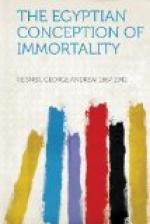From the First Dynasty, say from 3300 B.C. down, as soon as the Egyptian had mastered the use of mud-brick and wood, we gain the certainty of an idea which could only be guessed at in the primitive period. A place is provided above the grave at which the living could meet the spirit of the dead with periodical offerings of food and other necessities. In the life after death, spirit food and drink, once used, ceased to be, just as in life on earth, and had to be renewed from day to day, lest the spirit of the dead suffer from hunger and thirst. One of the great developments of the first six dynasties looked to the provision of these daily necessities.
The invention of writing was immediately utilized. About the beginning of the First Dynasty writing was invented for administrative and other practical purposes. Gravestones, bearing in relief the name of the dead, were set up in the offering places of the kings and court people. These were probably reminders for use in some simple formula recited in presenting the periodical offerings. As the Egyptians became more familiar with the use of writing, the offering formula was written out in full, enlarged and modified.
Sculptures, both relief and statuary, in every stage of their development, were used as magical accessories to the offering rites.
So, also, the whole history of Egyptian architecture was reflected in the tomb; for every advance brought about some change in the form or structure. In fact, the whole development of the form of the Egyptian tomb depended on the development of technical skill. The same funerary functions are served throughout. As all the great artisans were at the command of the king, all the great technical discoveries and inventions were first made in his service. But every permanent gain in knowledge was a benefit to the race and utilized by the common people. So, for example, the skill acquired in stone-cutting, during the construction of the great pyramids, was utilized a little later in producing rock-cut tombs from one end of Egypt to the other.
The functions of the grave remained the same. Yet with the changes in form resulting from the growth of skill, modifications in the funerary customs crept in.
The mud-brick tombs of the early part of the First Dynasty, like the pre-dynastic graves, had only one chamber, limited in size by the length of logs obtainable to form the roof. The growing desire for ostentation found a way to enlarge the tombs by building them with a number of chambers. The burial was placed in the central chamber and the burial furniture in the additional chambers. In this way the separation of the furniture and the actual burial was brought about.




